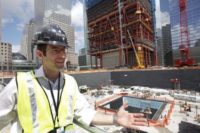I was working with the Tennessee Valley Authority’s (TVA) nuclear plant near Chattanooga doing an assessment of their safety culture. What I heard from them is a claim that I’ve heard many times since when interviewing employees at a company that claims to have a strong positive safety culture:
“Drive down the streets here and you’ll know who works here! You’ll see us mowing the lawn with full PPE, steel toed boots all the way up to safety glasses!”
They take PPE home!
Growing up
It made me reflect on my career as a lawn mower. I recalled mowing the lawn back when I had my first house. I was in my 20s, invincible and stupid. I’d mow my lawn with no gloves or glasses. My short pants were complimented with my lack of a shirt. I certainly didn’t bag the lawn clippings so rocks and sticks would fly out randomly.
As a safety geek I look back in embarrassment and a lot of thankfulness that I wasn’t seriously injured. Mowing the lawn nowadays I look more like those employees at TVA. I got steel-toed boots, long pants and shirt, leather gloves, safety glasses, the whole getup. I maintain the blades and bag the debris.
But it got me wondering… what made me change from the mower of my 20s to the safer version nowadays?
Many folks would answer — “Because you got hurt!” — thinking that the painful consequence of an injury would change my behavior. Indeed, I was mowing next to a tree one afternoon and hit a rock that shot out hitting the tree, ricocheted back and cut my exposed leg! Did I go back inside to my family and admit that I hurt myself? No, I snuck inside, cleaned it up and put on long pants to finish up the lawn. Did I keep wearing long pants and use the clippings bag thereafter? For a time or two…yes, but then back to shorts and no bagging. Funny but even an injury didn’t change my behavior.
Injuries do not motivate
Injuries are so unlikely to happen that they are not a powerful enough consequence to change behavior. The real and immediate consequences of the safe mowing behaviors are wearing heavy sweaty clothing and stopping all the time to clear out the clippings bag. Doing the safe behavior is more uncomfortable, typically more inconvenient, and takes more time. Quite simply, the positive consequences of being safe need to outweigh those negative consequences. In my case, they didn’t add up.
Sound like the consequences of safe behaviors at your workplace?
So what made me change? A second answer would be “You’re a dad and need to model the safe behaviors you want to see in your children”. Good answer. My first article for ISHN (June 2010) called "When Dad is a Safety Geek" told the story of the challenges getting my oldest son to wear knee and elbow pads as he skateboarded. My boys have a lot of safety requirements!
I took my youngest to see AC/DC in concert and, of course, we both wore earplugs (although, still, I tore mine in half to hear Angus’ solo better). Afterwards, he decided he wanted to be a rock n’ roll drummer. Concerned about a lifetime of jet-engine noise and the tinnitus that could result — just ask Pete Townsend of the Who — I decided to start him out right! So, I went so far as to buy my youngest son full ear protection the likes of which air service crews wear on runways!
The turning point
How then could I require all these safe behaviors in my kids then turn around and model risk in my own behaviors? My guess is that having kids is the turning point in our lives that we change from risk-accepting youthful ignorance to safety-seeking adult cautiousness (according to recent neurological research the myelin sheath, the fatty tissue surrounding our neurons in our brains, increases into adulthood, which helps inhibit more impulsive actions).
But even having kids didn’t seal the deal. Even then I wasn’t consistent in my safety behaviors and I would certainly take the same old risks when the kids were not around. What REALLY changed my behavior for good — even when no one else is watching?
Well, I was out mowing on nice Saturday afternoon. The kids were in the garage and I was fully outfitted… or so I thought. I was about halfway done with the lawn when my youngest, then around 9 years old, came running out to me waving. I put out my hand for him to stop and turned off the mower. What happened next changed my life. I still get choked up telling it.
Actively caring
He ran up…”Dad, dad…. You forgot these.” And he handed me his earmuffs I bought him for drumming because I did not have hearing protection.
Surely, I had knowledge of possible hazards and the injuries that could occur. Certainly, I knew that I was modeling behaviors that could influence others. But the biggest single thing that influences my safety choices to this very day was that act of caring offered by my son to me.
It wasn’t some top-down rule or procedure. It wasn’t some training seminar or incentive program. Instead it was he taking his time to protect me (or help me protect myself). He did that because he cares for me and now I will never let him down by taking unnecessary risks. I also firmly believe that he did this for me because I was looking out for him too.
A culture of caring
And this is how a strong safety culture works. A safety culture is not just one’s own personal safety behaviors. Nor is it the result of safety management systems or training. It’s not even the impact of leadership behaviors that emphasize that safety is a top priority.
Instead, a safety culture is a place where individuals offer acts of caring to each other. They do this through suggesting better protective equipment (like my son), offering safer alternatives to get the work done, volunteering their time to work on safety committees, by watching out for each other and giving feedback in a respectful and caring way. Peer-to-peer caring is the most powerful consequence there is in the workplace (and it’s also the cheapest).
So it gets me down when some safety professionals claim that behavior-based safety “doesn’t work.” When I look into BBS programs that seemed to have had limited effectiveness I find the typical trappings of an observation card and data analysis systems. But after digging a bit I find that the observations are being done by supervisors or by a “chosen few.” What is missing is the opportunity for peers to take a couple minutes to demonstrate their care for their fellow workers.
It’s a tricky thing to grow, this safety culture. It’s more than just an engineered process. Luckily we have our families to learn from.





